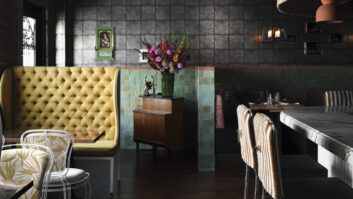
In the first part of this feature on acoustics in auditoriums we considered the subjective characteristics specific to concert halls that can add complexity to sound installs. Here Erica Basnicki looks at when a sound system should interact with the room acoustics and when this should be avoided, as well as revealing the added issues that come with retrofitting solutions to older venues.
Compromise also comes into play between architects and interior designers, who tend to favour the pleasing aesthetics of shiny, polished materials: beautiful to look at, yes, but less than ideal for controlling late reflections, which are a concert hall’s number one nuisance. This is not to say that the visual professionals go out of their way to make life difficult for the acoustic consultant, it’s simply the reality that – generally speaking – shiny, hard surfaces look nicer than softer ones. “Vicoustic always tries to come up with solutions that have a good acoustic performance, but also a good design,” notes João Ferreira, Vicoustic’s acoustic consultant.
The panels simply have an important job to do, and in a large auditorium “you use absorption to treat the space; that’s the main approach to it,” says Gustavo Pires, Vicoustic technical director.
Let’s not forget that loudspeakers are just as visible – if not more so – than acoustic panels. As Julien Laval, L-Acoustics’ application engineer, notes: “A concert hall has high aesthetic standards, so there’s a need for audio systems that are small in size and with a certain aesthetic in their design to be taken into account. There’s still a need for high SPL, but they must be small systems, and I think there’s a battle or race between manufacturers to respond to this.
“Sound system designers also need to get a little bit more education in acoustic criteria because sometimes it’s worth using the benefits of the room acoustics, and sometimes it’s not. When they don’t have the information about the room, the safe bet is to avoid an interaction with the room by having sharp directivity on the audience.”
APG’s marketing and business development director Gregory Dapsanse is passionate about directivity, and the vertical plane is just one element he focuses on: “Line arrays deliver very precise control of directivity in the vertical plane in order to guarantee a good acoustic coupling between each source, and to limit interference. Let’s say 95% of line array systems do that quite well. Very curiously, nobody cares about the horizontal control of directivity.
“This is something, as you might have guessed, that we really consider as a constraint in a line array system. We have only two line array systems in the APG range: the Uniline and the Uniline Compact. You can just look at the front panel, and there is a horn, respecting the acoustic rules to guarantee what we call constant directivity.”
Retrofitting a space is always a bigger challenge because sometimes that space isn’t necessarily well-thought for the function it serves
Gustavo Pires, Vicoustic
New sound
When it comes time to improving the acoustic performance of an existing auditorium, the temptation is to assume an older sound system is the problem, and that a newer one will make everything better. Not so, says Richard Northwood, principal consultant, design and engineering at RH Consulting.
“You really have to work out what the problem is first, which has nothing to do with technology; it’s more about listening to the client. A lot of jobs come down to that; you listen to what they think their problem is, and you try and work out if (technology) is really what the problem is, or whether it’s actually something else.”
Often, the problem is the room itself. The hope with a newly built auditorium is that it will sound great from the start. In Europe especially, many concert halls were built long before it was ever possible to model a space and treat it accordingly. The former is accomplished much more readily than the latter: “Retrofitting a space is always a bigger challenge because sometimes that space isn’t necessarily well-thought for the function it serves,” says Pires. “For example, if the space has a concave surface or some kind of design feature that creates echoes, you need to find ways to solve those issues.”
The issues that acoustic consultants face in a retrofit are largely the same as those of a new venue: striking a balance between the optimal acoustic treatment and the visual impact it will have on the space. It’s the visuals that tend to win, especially when the auditorium in question is of any significant heritage. “It’s always a compromise between people,” acknowledges Pires.
Even if a new sound system is exactly what’s required to give an older space a new sound, installing it won’t necessarily be straightforward: “To me the retrofitting challenge is really about upgrading equipment to have network capabilities, and concern about weight limits,” explains Laval, “especially in concert halls where there’s a will to keep it the way it has been in the past. The retrofitting challenges to me are not really on the acoustic side. Any concert hall has its own personal acoustic challenge. For me the challenge is whether or not to take advantage of that acoustic identity.”
Here technology must step in as best as it can, and keep the interaction between sound and space to a bare minimum if necessary. “It is important for the system designer to use directional point sources or arrays with horizontal and vertical control, or beam-steerable arrays where vertical sound beams can be tight and aimed only to areas with listeners,” explains Michał Popławski, technical sales manager, Europe for Renkus-Heinz.
New format?
L-Acoustics also has thoughts on how the concert experience might evolve in the future: “Lighting and video have expanded a lot in the last 10 years,” says Laval. “To match audio with these new levels of visual experience, there’s a need for something other than stereo.”
Enter L-ISA, the company’s new multichannel system the promises an “immersive sensation that people are looking for,” says Laval. “The traditional stereo system works very well in the living room, but in a venue when you have a big left-right system, actually for most people it’s a dual mono system. It’s completely different.
“Of course the challenge with L-ISA is that it requires more speakers than traditional stereo, but equipment is getting smaller and more powerful each year. At some point those two characteristics are going to match and provide some innovation for concert halls.”
www.apg.audio
www.l-acoustics.com
www.renkus-heinz.com
www.rhconsulting.eu
www.vicoustic.com







